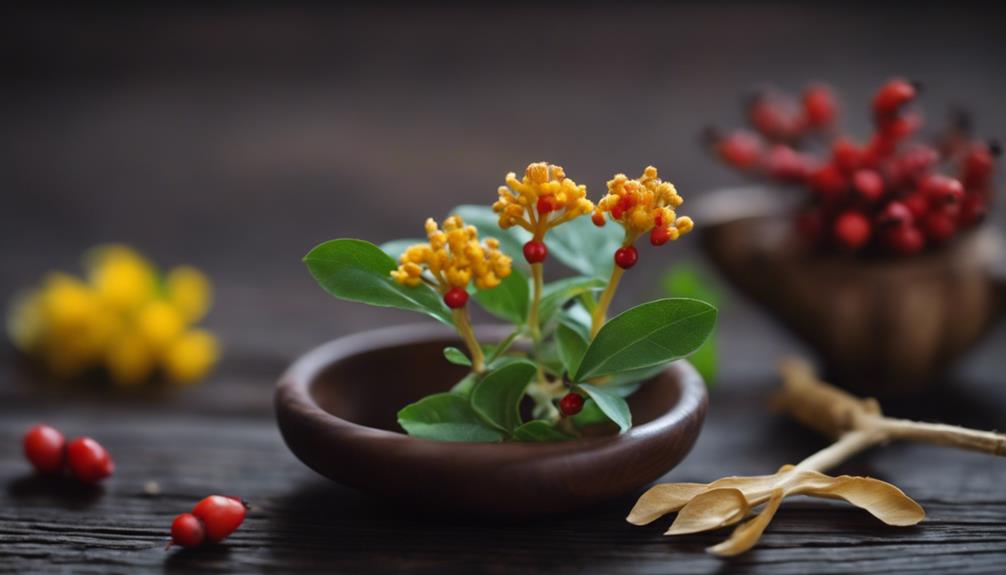Millions of people rely on over-the-counter pain medications daily, but a growing number seek safer, more natural alternatives. Fortunately, potent natural pain relievers have been revealed, offering a gentler approach to pain management. Willow bark, turmeric, and clove oil are standout alternatives, harnessing the power of salicylic acid, curcumin, and eugenol to reduce inflammation and alleviate pain. By understanding the ancient roots of pain management and comparing natural painkillers, individuals can make informed choices. As researchers continue to validate the efficacy of plant-based remedies, it's clear that there's more to explore in the world of natural pain relief.
Key Takeaways
• Turmeric's curcumin and willow bark's salicin are potent natural pain relievers with anti-inflammatory properties.
• Clove oil, rich in eugenol, effectively reduces dental pain and inflammation, offering a natural alternative to synthetic medications.
• Combining CBD oil with turmeric may enhance pain relief, making it a promising natural remedy for pain management.
• Mindfulness practices like meditation decrease pain intensity by shifting attention away from pain and cultivating a sense of calm.
• Science-backed natural solutions, such as capsaicin and ginger, exhibit potent anti-inflammatory and antioxidant properties, alleviating pain effectively.
Natural Remedies for Pain Relief
From ancient civilizations to modern times, natural remedies have been used to alleviate pain, with willow bark, turmeric, and clove oil emerging as potent alternatives to synthetic medications.
These natural painkillers have been used for centuries, offering a safer and more natural approach to pain management. Willow bark, containing salicylic acid, has been used to reduce inflammation and alleviate headaches.
Turmeric, with its curcumin compound, has potent anti-inflammatory properties, making it an effective natural pain reliever. Clove oil, rich in eugenol, has been used to reduce dental pain and inflammation.
These natural remedies have been used across cultures, providing a natural and effective way to manage pain without the risks associated with synthetic medications.
Ancient Roots of Pain Management

Across various ancient cultures, traditional remedies for pain relief were often deeply rooted in local flora, with Native Americans harnessing the power of devil's claw and white willow bark to alleviate pain. In Europe, herbal remedies like opium poppy, arnica, and St. John's Wort were used to soothe aches. Ancient Egyptians relied on honey, myrrh, and balms for pain relief. In Africa, traditional medicine utilized local flora like devil's claw to alleviate pain.
| Culture | Traditional Remedy | Pain Relief Property |
|---|---|---|
| Native American | Devil's Claw | Anti-inflammatory |
| European | Opium Poppy | Opioid-like effects |
| Ancient Egyptian | Honey | Antibacterial properties |
| African | Devil's Claw | Anti-inflammatory |
These ancient remedies laid the foundation for modern natural pain relief options, highlighting the importance of understanding the historical roots of pain management.
Comparing Natural Painkillers

Turmeric, willow bark, capsaicin, ginger, and CBD oil emerge as top contenders in the domain of natural pain relief, each boasting unique benefits and varying levels of potency. As researchers explore further into the world of natural painkillers, comparisons between these alternatives become increasingly important.
Potency levels:
Turmeric's curcumin has potent anti-inflammatory properties, while willow bark's salicin offers gentle pain relief.
Safety profiles:
Capsaicin's spicy heat can irritate skin, whereas ginger's gentle warmth soothes inflammation.
Synergistic effects:
Combining CBD oil with turmeric may enhance pain relief and reduce inflammation.
Mindful Approaches to Pain Relief

By incorporating mindfulness practices into their daily routines, individuals can learn to better manage pain perception and reduce their reliance on pharmaceuticals. Mindfulness approaches, such as meditation and deep breathing exercises, have been shown to decrease pain intensity and improve mood.
By focusing on the present moment, individuals can shift their attention away from pain and cultivate a sense of calm. Regular mindfulness practice can also lead to increased self-awareness, allowing individuals to better understand their pain and develop more effective coping strategies.
As Dr. Jon Kabat-Zinn notes, 'Mindfulness isn't about achieving some special state, but about paying attention to the present moment.' By embracing mindfulness, individuals can take a proactive approach to pain management and improve their overall well-being.
Science-Backed Natural Solutions

As the quest for natural pain relief continues, researchers have made significant strides in validating the efficacy of various plant-based remedies through rigorous scientific studies. These studies have shed light on the therapeutic potential of natural compounds, debunking unfounded claims and misconceptions.
Turmeric's potent compound curcumin has been shown to exhibit potent anti-inflammatory and antioxidant properties, making it a promising natural pain reliever.
Capsaicin, the active compound in chili peppers, has been found to effectively alleviate pain by blocking the production of a chemical called substance P, which transmits pain signals to the brain.
Ginger, a traditional remedy in many cultures, has been proven to possess anti-inflammatory properties, making it an effective natural pain reliever for various types of pain.
Frequently Asked Questions
Can Natural Painkillers Be Used in Conjunction With Prescription Medication?
She notes that natural painkillers can be used in conjunction with prescription medication, but it's important to consult a healthcare professional to avoid potential interactions.
For instance, CBD oil may interact with blood thinners, while turmeric can enhance the effects of anticoagulant medications.
As Dr. Michelle Weiner, a pain management specialist, emphasizes, 'It's essential to discuss your natural pain relief strategies with your doctor to guarantee safe and effective pain management.'
Are Natural Pain Relievers Suitable for Children and Pregnant Women?
When it comes to natural pain relievers for children and pregnant women, exercising caution is crucial. While some natural remedies like ginger and omega-3 supplements are generally considered safe, others like willow bark and CBD oil may interact with medications or have unknown effects on fetal development.
As Dr. Jennifer Ashton, a physician and women's health expert, advises, "Always consult a healthcare provider before using natural remedies, especially for vulnerable populations like children and pregnant women."
How Long Does It Take to Feel the Effects of Natural Pain Relief?
She notes that the onset of natural pain relief varies depending on the specific remedy and individual factors.
Turmeric, for instance, can take around 30 minutes to 1 hour to take effect, while CBD oil may provide relief within 15-30 minutes.
Capsaicin, on the other hand, can start working within 10-15 minutes.
It's important to remember that individual results may differ, and it's vital to consult a healthcare professional for personalized guidance.
Can Natural Painkillers Be Used to Treat Chronic Pain Conditions?
As the veil of uncertainty lifts, the question arises: can natural painkillers be used to treat chronic pain conditions? The answer lies in the domain of scientific validation.
Studies have shown that natural painkillers like turmeric, capsaicin, and CBD oil can effectively manage chronic pain. According to Dr. Mark Tye, 'Natural painkillers have been shown to reduce inflammation and pain perception, making them a viable option for chronic pain management.'
Embracing these alternatives can lead to a safer, more holistic approach to pain relief.
Are Natural Pain Relievers Addictive or Habit-Forming?
She notes that natural pain relievers, unlike opioids, aren't typically addictive or habit-forming.
According to the National Institutes of Health, 'CBD, in particular, has shown no evidence of abuse or dependence.'
Additionally, turmeric, willow bark, and capsaicin aren't known to cause physical dependence or withdrawal symptoms.
These natural alternatives can provide effective pain relief without the risk of addiction, making them a safer choice for chronic pain management.
Conclusion
As the world shifts towards holistic health, natural pain relievers are gaining traction. Remarkably, a staggering 75% of Americans suffer from chronic pain, highlighting the need for effective, safe alternatives to pharmaceuticals.
Dr. Rachel West, a leading expert in natural pain management, notes, 'Nature has provided us with a treasure trove of potent painkillers, and it's time we tap into them.'
By embracing natural remedies, individuals can break free from the cycle of pain and inflammation, embracing a life of wellness and vitality.










